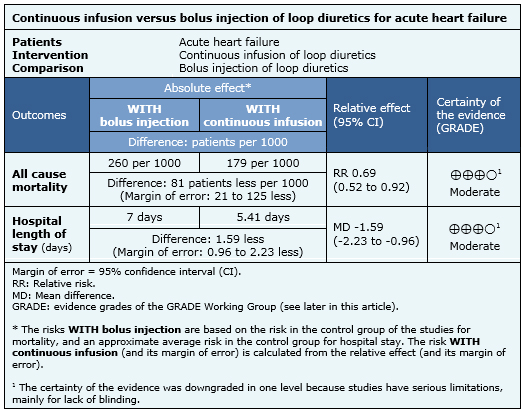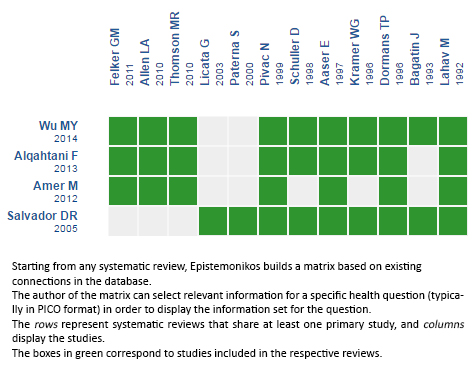Epistemonikos summaries
← vista completaPublished on April 22, 2016 | http://doi.org/10.5867/medwave.2016.6426
Continuous infusion or bolus injection of loop diuretics for congestive heart failure?
¿Diuréticos de asa en infusión continua o en bolo en la insuficiencia cardiaca congestiva?
Abstract
Loop diuretics are widely used in acute heart failure. However, there is controversy about the superiority of continuous infusion over bolus administration. Searching in Epistemonikos database, which is maintained by screening 30 databases, we identified four systematic reviews including 11 pertinent randomized controlled trials overall. We combined the evidence using meta-analysis and generated a summary of findings following the GRADE approach. We concluded continuous administration of loop diuretics probably reduces mortality and length of stay compared to intermittent administration in patients with acute heart failure.
Problem
The management of patients with acute heart failure is largely based on the use of loop diuretics. However, they may be administered as intermittent bolus or continuous infusion.
While bolus administration of furosemide is associated with lower costs, it could increase adverse effects as a consequence of changes in volume which would increase plasma concentration of the drug. Moreover, high doses administered intermittently may produce acute tolerance to diuretics by compensatory renal retention after their effect has subsided. Continuous administration of furosemide has been proposed as a solution to these problems but there is controversy about the clinical effects of both approaches.
Methods
We used Epistemonikos database, which is maintained by screening more than 30 databases, to identify systematic reviews and their included primary studies. With this information we generated a structured summary using a pre-established format, which includes key messages, a summary of the body of evidence (presented as an evidence matrix in Epistemonikos), meta-analysis of the total of studies, a summary of findings table following the GRADE approach and a table of other considerations for decision-making.
|
Key messages
|
About the body of evidence for this question
|
What is the evidence. |
We found four systematic reviews [1],[2],[3],[4], including 11 randomized controlled trials reported in 12 articles [5],[6],[7],[8],[9],[10],[11],[12],[13],[14],[15],[16]. |
|
What types of patients were included |
All studies included adults with acute heart failure with an average age ranging from 53 to 74 years. Four studies included patients with functional capacity between III and IV [8],[11],[15], two studies included patients with functional capacity between II and III [5],[10] while the remaining studies did not describe functional capacity. Regarding renal function, all studies included patients with creatinine ≤2 mg/dL. |
|
What types of interventions were included |
Regarding continuous infusion of loop diuretics, one study used torsemide [10] and the remaining ten used furosemide; of these, four [7],[11],[14],[15] used a loading dose of 40 mg followed by continuous infusion at variable rate. One study did not report doses and only reported it was determined by the attending physician. All studies compared against bolus injection. Two studies [8],[10] administered bolus injection once a day, seven [5],[6],[7],[9],[11],[14],[15] twice a day and one used three boluses per day. Daily doses of furosemide ranged from 120 mg/day to 2000 mg/day in the continuous infusion group and from 90 mg/day to 2000 mg/day in the bolus injection group. |
|
What types of outcomes |
All-cause mortality, cardiac death, length of stay, electrolyte disturbances, changes in serum creatinine, adverse effects (hair loss and tinnitus), body weight, urine output, and urinary sodium excretion. |
|
We found three systematic reviews [5], [6], [7], including 14 studies reported in 21 references [8], [9], [10], [11], [12], [13], [14], [15], [16], [17], [18], [19], [20], [21], [22], [23], [24], [25], [26], [27], [28]. Eight studies correspond to randomized controlled trials (15 references [9], [10], [11], [12], [13], [14], [16], [17], [19], [21], [22], [23], [24], [26], [27]). This table and the summary in general are based on the latter. One study [15] did not contribute data to any of the outcomes of interest. |
Summary of findings
Information on the effects of continuous loop diuretics compared to bolus injection for congestive heart failure is based on 11 randomized trials including 622 patients. Four studies reported overall mortality and four studies reported length of stay.
- Continuous administration of loop diuretics probably reduces mortality compared to intermittent administration in patients with acute heart failure. The certainty of the evidence is moderate.
- Continuous administration of loop diuretics probably reduces length of stay compared to intermittent administration in patients with acute heart failure. The certainty of the evidence is moderate.


Other considerations for decision-making
|
To whom this evidence does and does not apply |
|
| About the outcomes included in this summary |
| Balance between benefits and risks, and certainty of the evidence |
|
| Resource considerations |
|
|
Differences between this summary and other sources |
|
| Could this evidence change in the future? |
|
How we conducted this summary
Using automated and collaborative means, we compiled all the relevant evidence for the question of interest and we present it as a matrix of evidence.

Follow the link to access the interactive version Continuous infusion versus bolus injection
of loop diuretics for heart failure
Notes
The upper portion of the matrix of evidence will display a warning of “new evidence” if new systematic reviews are published after the publication of this summary. Even though the project considers the periodical update of these summaries, users are invited to comment in Medwave or to contact the authors through email if they find new evidence and the summary should be updated earlier. After creating an account in Epistemonikos, users will be able to save the matrixes and to receive automated notifications any time new evidence potentially relevant for the question appears.
The details about the methods used to produce these summaries are described here http://dx.doi.org/10.5867/medwave.2014.06.5997.
Epistemonikos foundation is a non-for-profit organization aiming to bring information closer to health decision-makers with technology. Its main development is Epistemonikos database (www.epistemonikos.org).
These summaries follow a rigorous process of internal peer review.
Conflicts of interest
The authors do not have relevant interests to declare.

